Antibody data
- Antibody Data
- Antigen structure
- References [2]
- Comments [0]
- Validations
- Immunohistochemistry [1]
- Other assay [5]
Submit
Validation data
Reference
Comment
Report error
- Product number
- PA5-27814 - Provider product page

- Provider
- Invitrogen Antibodies
- Product name
- EGR2 Polyclonal Antibody
- Antibody type
- Polyclonal
- Antigen
- Recombinant full-length protein
- Description
- Recommended positive controls: EGR2 tansfected 293T cell. Predicted reactivity: Mouse (90%), Rat (90%), Xenopus laevis (95%), Pig (95%), Rhesus Monkey (98%). Store product as a concentrated solution. Centrifuge briefly prior to opening the vial.
- Reactivity
- Human, Mouse
- Host
- Rabbit
- Isotype
- IgG
- Vial size
- 100 μL
- Concentration
- 1 mg/mL
- Storage
- Store at 4°C short term. For long term storage, store at -20°C, avoiding freeze/thaw cycles.
Submitted references Epithelial stem cell homeostasis in Meibomian gland development, dysfunction, and dry eye disease.
Partial Inhibition of Glycolysis Reduces Atherogenesis Independent of Intraplaque Neovascularization in Mice.
Tchegnon E, Liao CP, Ghotbi E, Shipman T, Wang Y, McKay RM, Le LQ
JCI insight 2021 Oct 22;6(20)
JCI insight 2021 Oct 22;6(20)
Partial Inhibition of Glycolysis Reduces Atherogenesis Independent of Intraplaque Neovascularization in Mice.
Perrotta P, Van der Veken B, Van Der Veken P, Pintelon I, Roosens L, Adriaenssens E, Timmerman V, Guns PJ, De Meyer GRY, Martinet W
Arteriosclerosis, thrombosis, and vascular biology 2020 May;40(5):1168-1181
Arteriosclerosis, thrombosis, and vascular biology 2020 May;40(5):1168-1181
No comments: Submit comment
Supportive validation
- Submitted by
- Invitrogen Antibodies (provider)
- Main image
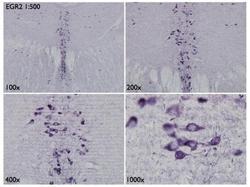
- Experimental details
- Immunohistochemical analysis of mouse brain tissue (paraformaldehyde-fixed frozen sections), using EGR2 (Product # PA5-27814) antibody at 1:500 dilution. Antigen Retrieval: Trilogy™ (EDTA based, pH 8.0) buffer, 15 min.
Supportive validation
- Submitted by
- Invitrogen Antibodies (provider)
- Main image
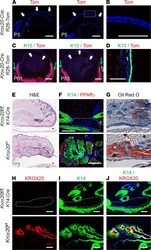
- Experimental details
- Figure 2 KROX20 protein is required for Meibomian gland development. ( A and C ) Lineage tracing in Krox20-Cre; R26-tdTomato ( Krox20-Cre; R26-Tom ) mice shows absence of KROX20 expression or Krox20 -lineage cells in the cornea (white arrows) and the limbus (green arrows). ( B ) The purple boxed region in A , which displays an image of ""P5 eye,"" is shown, with a high-magnification view of the cornea. ( C ) Immunofluorescence staining of eyeballs from Krox20-Cre;R26-Tom mice for limbus marker K15 and tdTomato (Tom). ( D ) The yellow boxed region in C , which displays an image of ""P83 eye,"" is shown, with a high-magnification view of the limbus. ( E ) H&E staining of 2.5-month-old Krox20-cKO mice shows absence of the Meibomian gland. ( F ) Immunofluorescence staining for K14 costained with PPARgamma. ( G ) Oil Red O staining showing absence of meibum in Krox20-cKO mice. ( H - J ) Immunofluorescence staining of Meibomian gland with KROX20 and K14 antibodies. Dashed lines (red in E and white in G - J ) demarcate the expected location of the Meibomian gland. n = 20 Krox20 fl/fl mice, and n = 25 Krox20-cKO mice. Among mice analyzed, 100% of Krox20-cKO mice lack the Meibomian gland. Representative images are shown. Scale bar: 100 mum.
- Submitted by
- Invitrogen Antibodies (provider)
- Main image
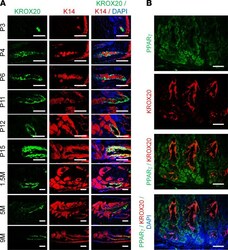
- Experimental details
- Figure 3 KROX20 is expressed in Meibomian gland during development and maintained throughout life. ( A ) Immunofluorescence staining of Krox20-GFP mice demonstrates KROX20 expression in the Meibomian gland at various ages. ( B ) Immunofluorescence staining for GFP (KROX20) and PPARgamma expression in Meibomian gland of P12 mice. Representative images are shown. M, months. Scale bar: 100 mum.
- Submitted by
- Invitrogen Antibodies (provider)
- Main image
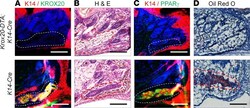
- Experimental details
- Figure 5 KROX20-positive cells are indispensable for Meibomian gland development. Krox20-DTA ; K14-Cre pups (P6) in which KROX20-expressing cells were deleted exhibit complete loss of Meibomian gland, as shown by coimmunostaining for ( A ) K14 and KROX20, ( B ) H&E staining, and ( C ) K14 and PPARgamma immunostaining. ( D ) These mice also failed to produce meibum, as shown by the lack of Oil Red O staining in the eyelid. Dashed lines (red in B and D and white in A and C ) demarcate the Meibomian glands in the control mice and its expected location in the Krox20-DTA;K14-Cre mice. n = 7 K14-Cre mice, and n = 11 Krox20-DTA;K14-Cre mice. Representative images are shown. Scale bar: 100 mum.
- Submitted by
- Invitrogen Antibodies (provider)
- Main image
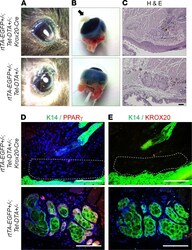
- Experimental details
- Figure 6 Inducible ablation of Krox20 -lineage cells in adult mice. Doxycycline-induced Krox20 -lineage cell ablation from P20 to P92 causes corneal lesions. ( A and B ) Gross images of eyes and eyeballs from rtTA-EGFP +/- ;Tet-DTA +/- ;Krox20-Cre mice and controls. The black arrow in B is pointing to the corneal lesion. ( C ) H&E staining as well as ( D ) immunofluorescence staining for K14 and PPARgamma and ( E ) K14 and KROX20 in the Meibomian glands from rtTA-EGFP +/- ; Tet-DTA +/- ; Krox20-Cre mice and controls. White dashed lines in C - E demarcate the Meibomian gland in the control mice and its expected location in the rtTA-EGFP +/- ; Tet-DTA +/- ; Krox20-Cre mice. n = 7 Krox20-DTA;K14-Cre mice, and n = 11 Krox20-DTA;K14-Cre mice. Representative images are shown. Scale bar: 100 mum.
- Submitted by
- Invitrogen Antibodies (provider)
- Main image
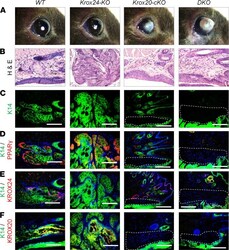
- Experimental details
- Figure 8 Absence of the Meibomian gland in mice lacking both Krox20 and Krox24 . ( A ) Gross images of the eye in Krox20 fl/fl (WT), Krox24 -/- ( Krox24-KO ), Krox20 fl/fl ;K14-Cre ( Krox20-cKO ), and Krox24 -/- ;Krox20 fl/fl ;K14-Cre ( DKO ) mice. ( B - F ) Histological analyses revealed the absence of the Meibomian gland (MG) in the eyelids of Krox20-cKO and DKO mice, whereas Krox24-KO and WT littermates maintained normal MG structure. Gross images in A are the same as those in Figure 7A , Supplemental Figure 1 (8M), and Supplemental Figure 2A . Dashed lines (red in B and white in C - F ) demarcate the Meibomian gland in the control mice and its expected location of the Meibomian glands in the KOs. n = 20 mice for each genotype. Representative images are shown. Scale bar: 100 mum.
 Explore
Explore Validate
Validate Learn
Learn Western blot
Western blot Immunohistochemistry
Immunohistochemistry